Executive Report: Disaster Health Management in Trinidad & Tobago
VerifiedAdded on 2023/05/29
|14
|3782
|374
Report
AI Summary
This report examines the disaster health management strategies employed in Trinidad and Tobago following the heavy rainfall and flooding event of October 18-19. The report provides background and context, highlighting the displacement of over 100,000 people and the swift response of government agencies in issuing alerts and spearheading rescue operations. It emphasizes the significance of disaster health management, particularly in mitigation, relief, rescue, and rehabilitation efforts. The report also addresses key strategic issues such as inadequate health infrastructure, disaster unpreparedness, and lack of disaster management education, offering recommendations for improvement, including enhancing health facility safety, promoting disaster preparedness, and fostering effective coordination among emergency services. The importance of specific legislations on disaster management and guaranteed reimbursement to disaster healthcare services is also highlighted. Desklib offers this report as part of its collection of solved assignments and past papers for students.
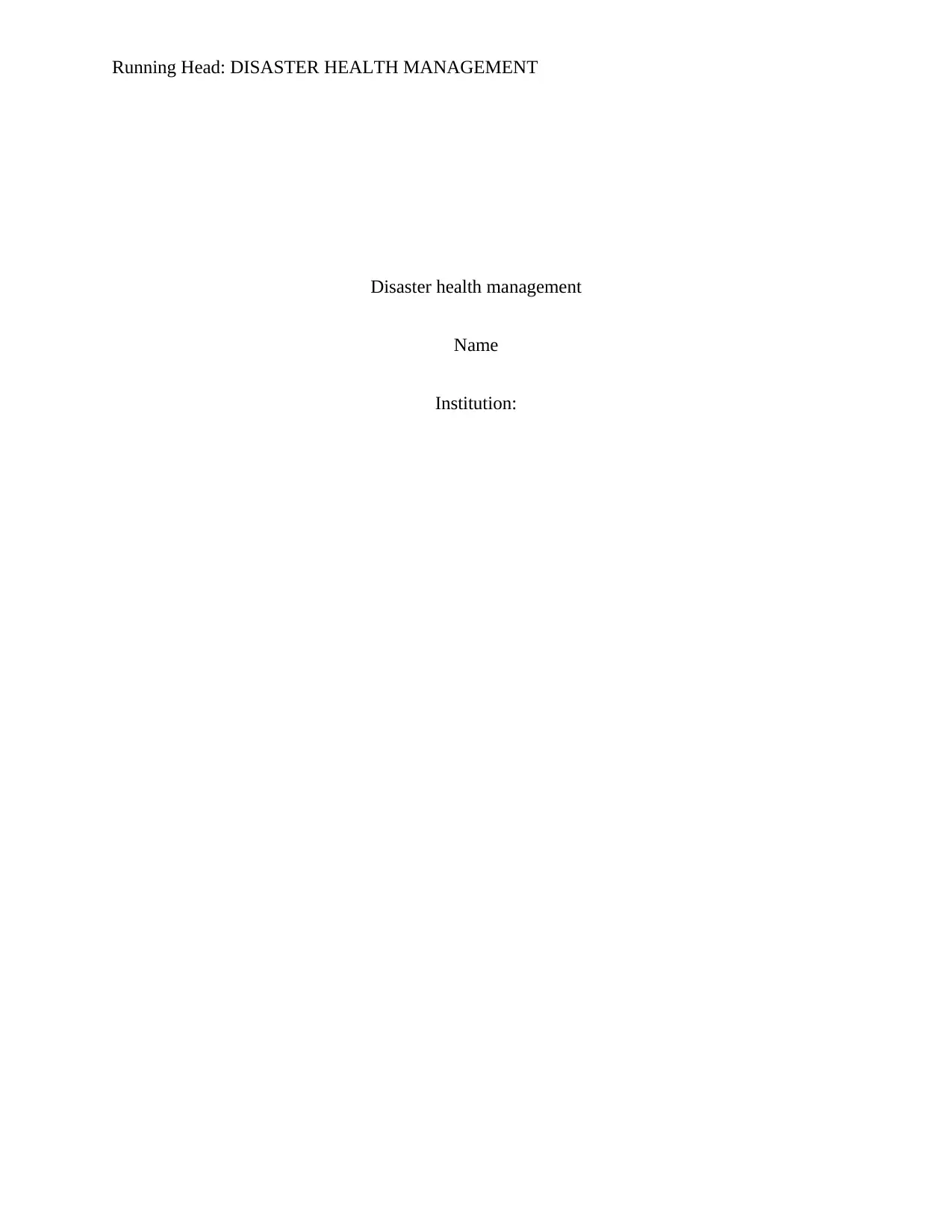
Running Head: DISASTER HEALTH MANAGEMENT
Disaster health management
Name
Institution:
Disaster health management
Name
Institution:
Paraphrase This Document
Need a fresh take? Get an instant paraphrase of this document with our AI Paraphraser
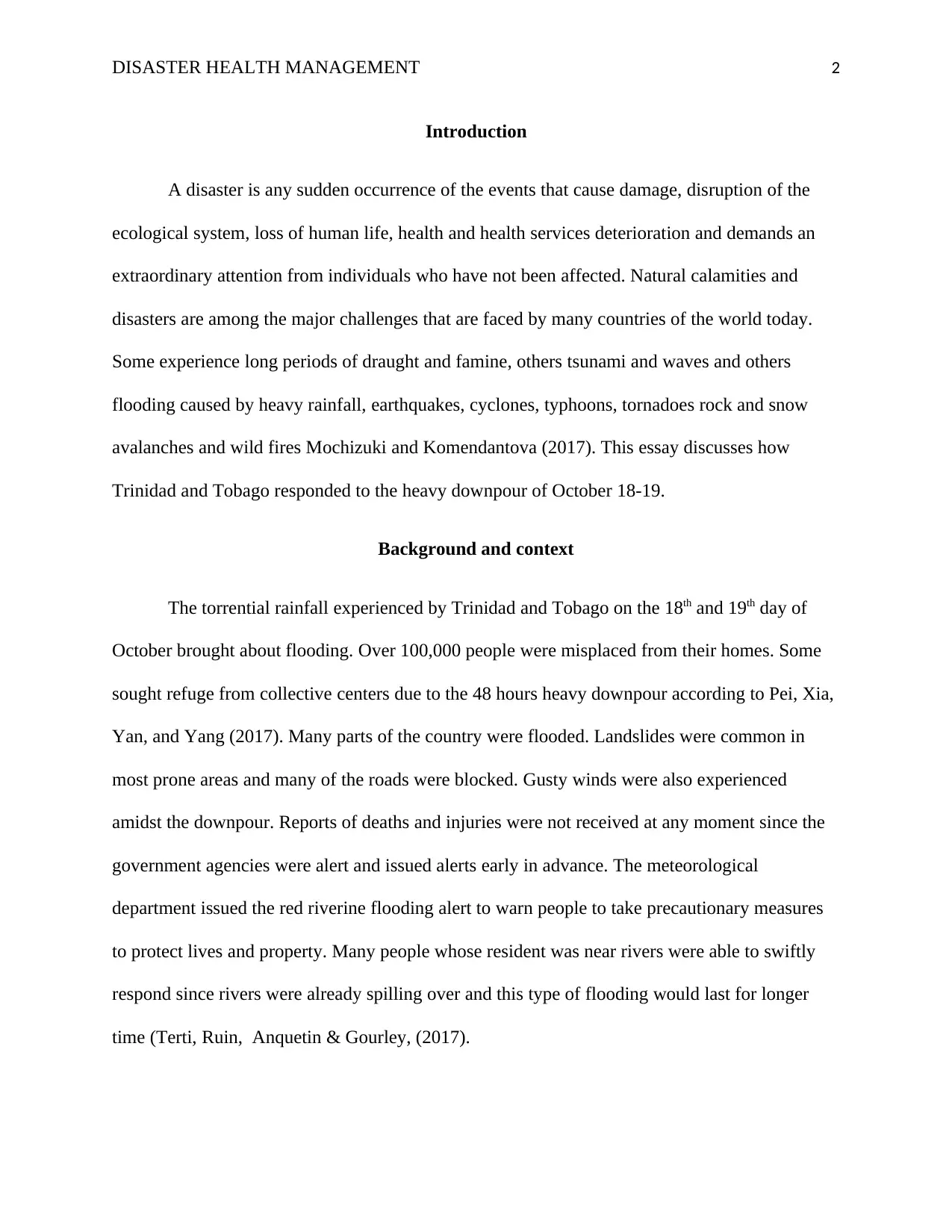
DISASTER HEALTH MANAGEMENT 2
Introduction
A disaster is any sudden occurrence of the events that cause damage, disruption of the
ecological system, loss of human life, health and health services deterioration and demands an
extraordinary attention from individuals who have not been affected. Natural calamities and
disasters are among the major challenges that are faced by many countries of the world today.
Some experience long periods of draught and famine, others tsunami and waves and others
flooding caused by heavy rainfall, earthquakes, cyclones, typhoons, tornadoes rock and snow
avalanches and wild fires Mochizuki and Komendantova (2017). This essay discusses how
Trinidad and Tobago responded to the heavy downpour of October 18-19.
Background and context
The torrential rainfall experienced by Trinidad and Tobago on the 18th and 19th day of
October brought about flooding. Over 100,000 people were misplaced from their homes. Some
sought refuge from collective centers due to the 48 hours heavy downpour according to Pei, Xia,
Yan, and Yang (2017). Many parts of the country were flooded. Landslides were common in
most prone areas and many of the roads were blocked. Gusty winds were also experienced
amidst the downpour. Reports of deaths and injuries were not received at any moment since the
government agencies were alert and issued alerts early in advance. The meteorological
department issued the red riverine flooding alert to warn people to take precautionary measures
to protect lives and property. Many people whose resident was near rivers were able to swiftly
respond since rivers were already spilling over and this type of flooding would last for longer
time (Terti, Ruin, Anquetin & Gourley, (2017).
Introduction
A disaster is any sudden occurrence of the events that cause damage, disruption of the
ecological system, loss of human life, health and health services deterioration and demands an
extraordinary attention from individuals who have not been affected. Natural calamities and
disasters are among the major challenges that are faced by many countries of the world today.
Some experience long periods of draught and famine, others tsunami and waves and others
flooding caused by heavy rainfall, earthquakes, cyclones, typhoons, tornadoes rock and snow
avalanches and wild fires Mochizuki and Komendantova (2017). This essay discusses how
Trinidad and Tobago responded to the heavy downpour of October 18-19.
Background and context
The torrential rainfall experienced by Trinidad and Tobago on the 18th and 19th day of
October brought about flooding. Over 100,000 people were misplaced from their homes. Some
sought refuge from collective centers due to the 48 hours heavy downpour according to Pei, Xia,
Yan, and Yang (2017). Many parts of the country were flooded. Landslides were common in
most prone areas and many of the roads were blocked. Gusty winds were also experienced
amidst the downpour. Reports of deaths and injuries were not received at any moment since the
government agencies were alert and issued alerts early in advance. The meteorological
department issued the red riverine flooding alert to warn people to take precautionary measures
to protect lives and property. Many people whose resident was near rivers were able to swiftly
respond since rivers were already spilling over and this type of flooding would last for longer
time (Terti, Ruin, Anquetin & Gourley, (2017).
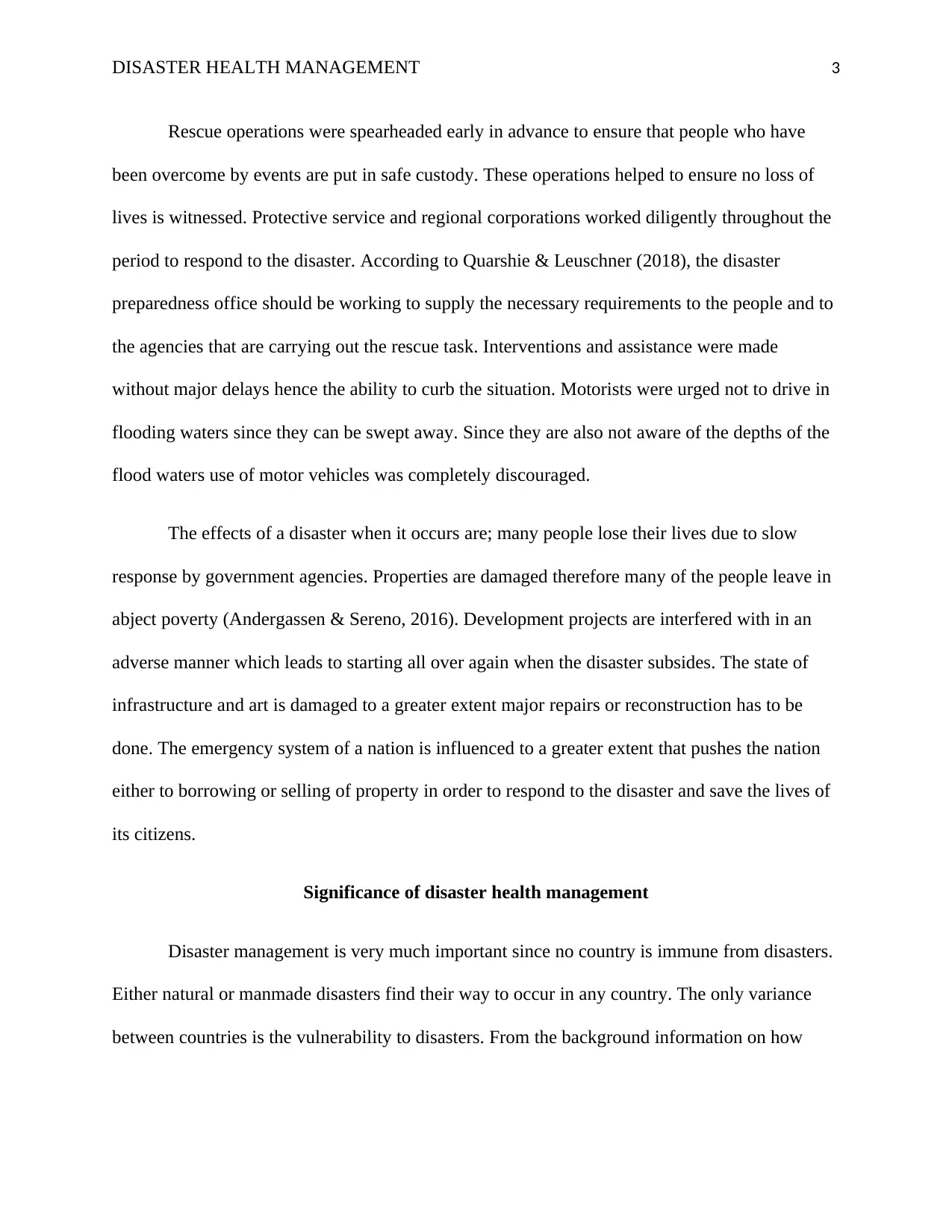
DISASTER HEALTH MANAGEMENT 3
Rescue operations were spearheaded early in advance to ensure that people who have
been overcome by events are put in safe custody. These operations helped to ensure no loss of
lives is witnessed. Protective service and regional corporations worked diligently throughout the
period to respond to the disaster. According to Quarshie & Leuschner (2018), the disaster
preparedness office should be working to supply the necessary requirements to the people and to
the agencies that are carrying out the rescue task. Interventions and assistance were made
without major delays hence the ability to curb the situation. Motorists were urged not to drive in
flooding waters since they can be swept away. Since they are also not aware of the depths of the
flood waters use of motor vehicles was completely discouraged.
The effects of a disaster when it occurs are; many people lose their lives due to slow
response by government agencies. Properties are damaged therefore many of the people leave in
abject poverty (Andergassen & Sereno, 2016). Development projects are interfered with in an
adverse manner which leads to starting all over again when the disaster subsides. The state of
infrastructure and art is damaged to a greater extent major repairs or reconstruction has to be
done. The emergency system of a nation is influenced to a greater extent that pushes the nation
either to borrowing or selling of property in order to respond to the disaster and save the lives of
its citizens.
Significance of disaster health management
Disaster management is very much important since no country is immune from disasters.
Either natural or manmade disasters find their way to occur in any country. The only variance
between countries is the vulnerability to disasters. From the background information on how
Rescue operations were spearheaded early in advance to ensure that people who have
been overcome by events are put in safe custody. These operations helped to ensure no loss of
lives is witnessed. Protective service and regional corporations worked diligently throughout the
period to respond to the disaster. According to Quarshie & Leuschner (2018), the disaster
preparedness office should be working to supply the necessary requirements to the people and to
the agencies that are carrying out the rescue task. Interventions and assistance were made
without major delays hence the ability to curb the situation. Motorists were urged not to drive in
flooding waters since they can be swept away. Since they are also not aware of the depths of the
flood waters use of motor vehicles was completely discouraged.
The effects of a disaster when it occurs are; many people lose their lives due to slow
response by government agencies. Properties are damaged therefore many of the people leave in
abject poverty (Andergassen & Sereno, 2016). Development projects are interfered with in an
adverse manner which leads to starting all over again when the disaster subsides. The state of
infrastructure and art is damaged to a greater extent major repairs or reconstruction has to be
done. The emergency system of a nation is influenced to a greater extent that pushes the nation
either to borrowing or selling of property in order to respond to the disaster and save the lives of
its citizens.
Significance of disaster health management
Disaster management is very much important since no country is immune from disasters.
Either natural or manmade disasters find their way to occur in any country. The only variance
between countries is the vulnerability to disasters. From the background information on how
⊘ This is a preview!⊘
Do you want full access?
Subscribe today to unlock all pages.

Trusted by 1+ million students worldwide
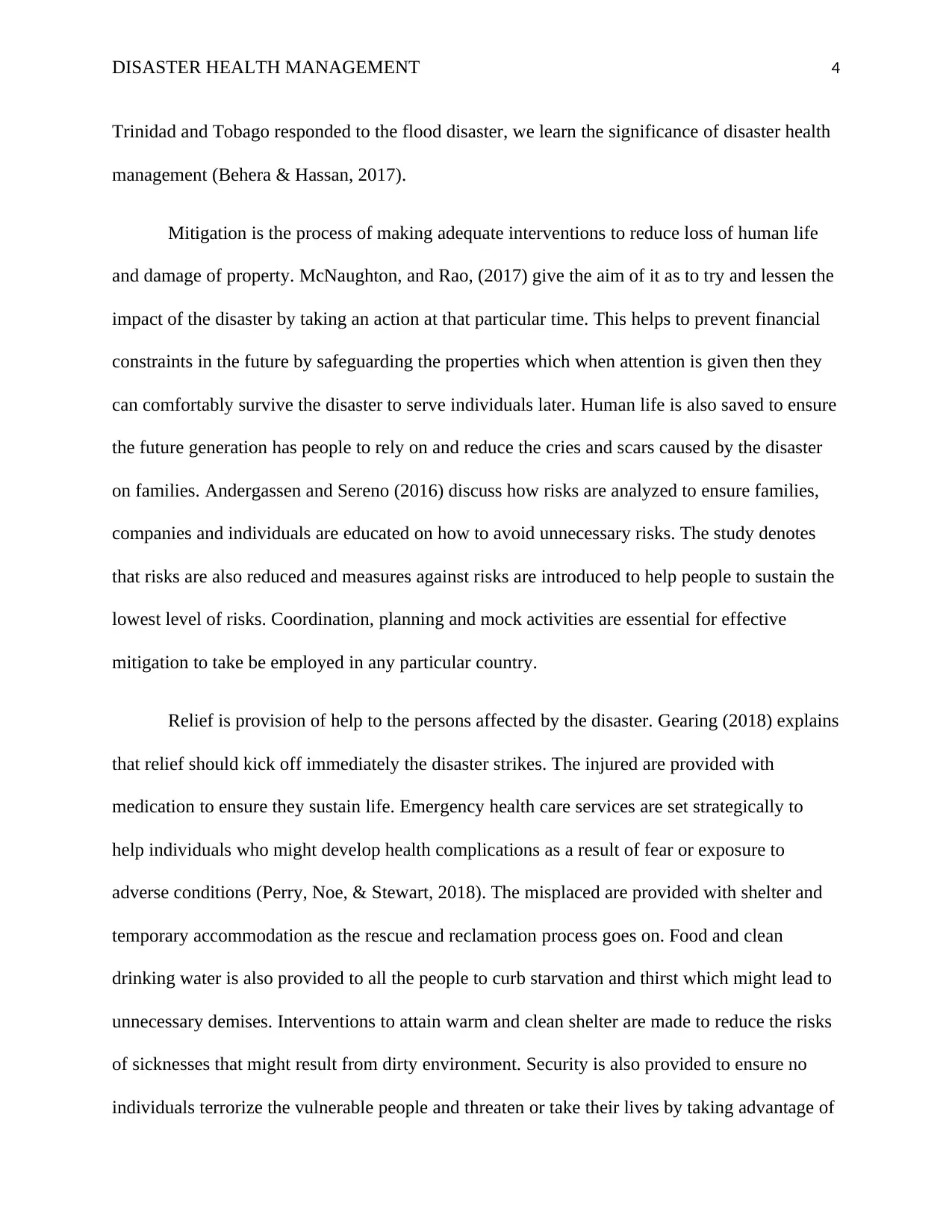
DISASTER HEALTH MANAGEMENT 4
Trinidad and Tobago responded to the flood disaster, we learn the significance of disaster health
management (Behera & Hassan, 2017).
Mitigation is the process of making adequate interventions to reduce loss of human life
and damage of property. McNaughton, and Rao, (2017) give the aim of it as to try and lessen the
impact of the disaster by taking an action at that particular time. This helps to prevent financial
constraints in the future by safeguarding the properties which when attention is given then they
can comfortably survive the disaster to serve individuals later. Human life is also saved to ensure
the future generation has people to rely on and reduce the cries and scars caused by the disaster
on families. Andergassen and Sereno (2016) discuss how risks are analyzed to ensure families,
companies and individuals are educated on how to avoid unnecessary risks. The study denotes
that risks are also reduced and measures against risks are introduced to help people to sustain the
lowest level of risks. Coordination, planning and mock activities are essential for effective
mitigation to take be employed in any particular country.
Relief is provision of help to the persons affected by the disaster. Gearing (2018) explains
that relief should kick off immediately the disaster strikes. The injured are provided with
medication to ensure they sustain life. Emergency health care services are set strategically to
help individuals who might develop health complications as a result of fear or exposure to
adverse conditions (Perry, Noe, & Stewart, 2018). The misplaced are provided with shelter and
temporary accommodation as the rescue and reclamation process goes on. Food and clean
drinking water is also provided to all the people to curb starvation and thirst which might lead to
unnecessary demises. Interventions to attain warm and clean shelter are made to reduce the risks
of sicknesses that might result from dirty environment. Security is also provided to ensure no
individuals terrorize the vulnerable people and threaten or take their lives by taking advantage of
Trinidad and Tobago responded to the flood disaster, we learn the significance of disaster health
management (Behera & Hassan, 2017).
Mitigation is the process of making adequate interventions to reduce loss of human life
and damage of property. McNaughton, and Rao, (2017) give the aim of it as to try and lessen the
impact of the disaster by taking an action at that particular time. This helps to prevent financial
constraints in the future by safeguarding the properties which when attention is given then they
can comfortably survive the disaster to serve individuals later. Human life is also saved to ensure
the future generation has people to rely on and reduce the cries and scars caused by the disaster
on families. Andergassen and Sereno (2016) discuss how risks are analyzed to ensure families,
companies and individuals are educated on how to avoid unnecessary risks. The study denotes
that risks are also reduced and measures against risks are introduced to help people to sustain the
lowest level of risks. Coordination, planning and mock activities are essential for effective
mitigation to take be employed in any particular country.
Relief is provision of help to the persons affected by the disaster. Gearing (2018) explains
that relief should kick off immediately the disaster strikes. The injured are provided with
medication to ensure they sustain life. Emergency health care services are set strategically to
help individuals who might develop health complications as a result of fear or exposure to
adverse conditions (Perry, Noe, & Stewart, 2018). The misplaced are provided with shelter and
temporary accommodation as the rescue and reclamation process goes on. Food and clean
drinking water is also provided to all the people to curb starvation and thirst which might lead to
unnecessary demises. Interventions to attain warm and clean shelter are made to reduce the risks
of sicknesses that might result from dirty environment. Security is also provided to ensure no
individuals terrorize the vulnerable people and threaten or take their lives by taking advantage of
Paraphrase This Document
Need a fresh take? Get an instant paraphrase of this document with our AI Paraphraser
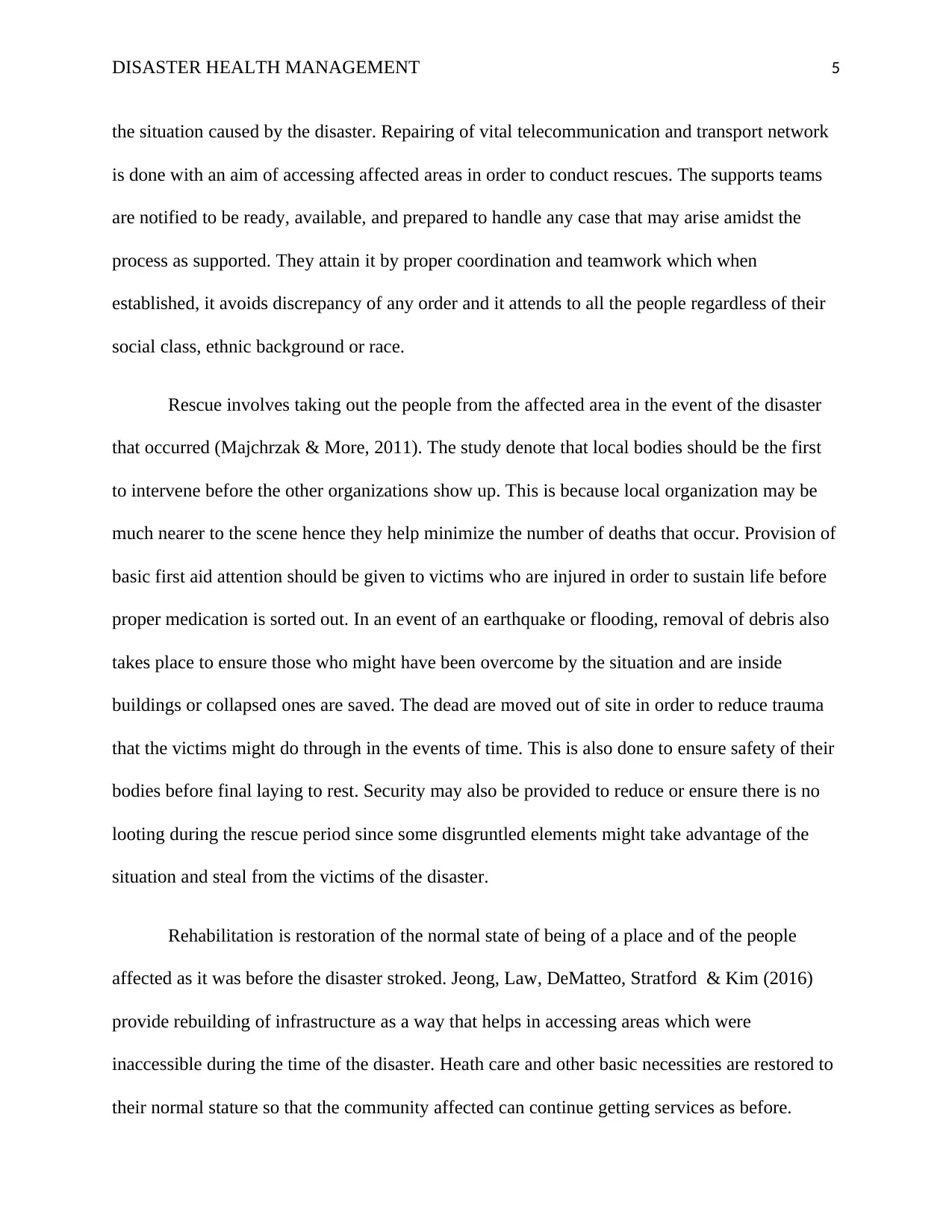
DISASTER HEALTH MANAGEMENT 5
the situation caused by the disaster. Repairing of vital telecommunication and transport network
is done with an aim of accessing affected areas in order to conduct rescues. The supports teams
are notified to be ready, available, and prepared to handle any case that may arise amidst the
process as supported. They attain it by proper coordination and teamwork which when
established, it avoids discrepancy of any order and it attends to all the people regardless of their
social class, ethnic background or race.
Rescue involves taking out the people from the affected area in the event of the disaster
that occurred (Majchrzak & More, 2011). The study denote that local bodies should be the first
to intervene before the other organizations show up. This is because local organization may be
much nearer to the scene hence they help minimize the number of deaths that occur. Provision of
basic first aid attention should be given to victims who are injured in order to sustain life before
proper medication is sorted out. In an event of an earthquake or flooding, removal of debris also
takes place to ensure those who might have been overcome by the situation and are inside
buildings or collapsed ones are saved. The dead are moved out of site in order to reduce trauma
that the victims might do through in the events of time. This is also done to ensure safety of their
bodies before final laying to rest. Security may also be provided to reduce or ensure there is no
looting during the rescue period since some disgruntled elements might take advantage of the
situation and steal from the victims of the disaster.
Rehabilitation is restoration of the normal state of being of a place and of the people
affected as it was before the disaster stroked. Jeong, Law, DeMatteo, Stratford & Kim (2016)
provide rebuilding of infrastructure as a way that helps in accessing areas which were
inaccessible during the time of the disaster. Heath care and other basic necessities are restored to
their normal stature so that the community affected can continue getting services as before.
the situation caused by the disaster. Repairing of vital telecommunication and transport network
is done with an aim of accessing affected areas in order to conduct rescues. The supports teams
are notified to be ready, available, and prepared to handle any case that may arise amidst the
process as supported. They attain it by proper coordination and teamwork which when
established, it avoids discrepancy of any order and it attends to all the people regardless of their
social class, ethnic background or race.
Rescue involves taking out the people from the affected area in the event of the disaster
that occurred (Majchrzak & More, 2011). The study denote that local bodies should be the first
to intervene before the other organizations show up. This is because local organization may be
much nearer to the scene hence they help minimize the number of deaths that occur. Provision of
basic first aid attention should be given to victims who are injured in order to sustain life before
proper medication is sorted out. In an event of an earthquake or flooding, removal of debris also
takes place to ensure those who might have been overcome by the situation and are inside
buildings or collapsed ones are saved. The dead are moved out of site in order to reduce trauma
that the victims might do through in the events of time. This is also done to ensure safety of their
bodies before final laying to rest. Security may also be provided to reduce or ensure there is no
looting during the rescue period since some disgruntled elements might take advantage of the
situation and steal from the victims of the disaster.
Rehabilitation is restoration of the normal state of being of a place and of the people
affected as it was before the disaster stroked. Jeong, Law, DeMatteo, Stratford & Kim (2016)
provide rebuilding of infrastructure as a way that helps in accessing areas which were
inaccessible during the time of the disaster. Heath care and other basic necessities are restored to
their normal stature so that the community affected can continue getting services as before.
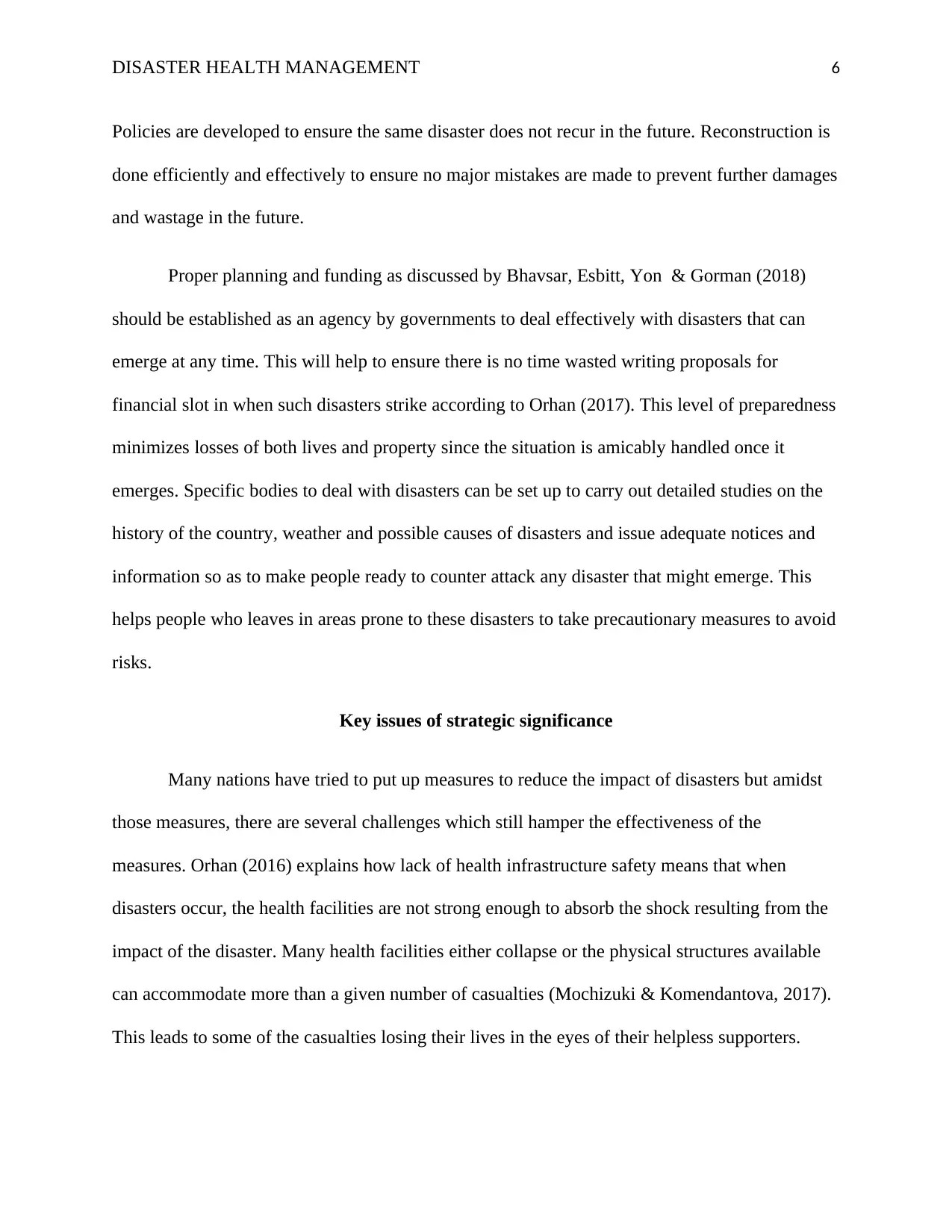
DISASTER HEALTH MANAGEMENT 6
Policies are developed to ensure the same disaster does not recur in the future. Reconstruction is
done efficiently and effectively to ensure no major mistakes are made to prevent further damages
and wastage in the future.
Proper planning and funding as discussed by Bhavsar, Esbitt, Yon & Gorman (2018)
should be established as an agency by governments to deal effectively with disasters that can
emerge at any time. This will help to ensure there is no time wasted writing proposals for
financial slot in when such disasters strike according to Orhan (2017). This level of preparedness
minimizes losses of both lives and property since the situation is amicably handled once it
emerges. Specific bodies to deal with disasters can be set up to carry out detailed studies on the
history of the country, weather and possible causes of disasters and issue adequate notices and
information so as to make people ready to counter attack any disaster that might emerge. This
helps people who leaves in areas prone to these disasters to take precautionary measures to avoid
risks.
Key issues of strategic significance
Many nations have tried to put up measures to reduce the impact of disasters but amidst
those measures, there are several challenges which still hamper the effectiveness of the
measures. Orhan (2016) explains how lack of health infrastructure safety means that when
disasters occur, the health facilities are not strong enough to absorb the shock resulting from the
impact of the disaster. Many health facilities either collapse or the physical structures available
can accommodate more than a given number of casualties (Mochizuki & Komendantova, 2017).
This leads to some of the casualties losing their lives in the eyes of their helpless supporters.
Policies are developed to ensure the same disaster does not recur in the future. Reconstruction is
done efficiently and effectively to ensure no major mistakes are made to prevent further damages
and wastage in the future.
Proper planning and funding as discussed by Bhavsar, Esbitt, Yon & Gorman (2018)
should be established as an agency by governments to deal effectively with disasters that can
emerge at any time. This will help to ensure there is no time wasted writing proposals for
financial slot in when such disasters strike according to Orhan (2017). This level of preparedness
minimizes losses of both lives and property since the situation is amicably handled once it
emerges. Specific bodies to deal with disasters can be set up to carry out detailed studies on the
history of the country, weather and possible causes of disasters and issue adequate notices and
information so as to make people ready to counter attack any disaster that might emerge. This
helps people who leaves in areas prone to these disasters to take precautionary measures to avoid
risks.
Key issues of strategic significance
Many nations have tried to put up measures to reduce the impact of disasters but amidst
those measures, there are several challenges which still hamper the effectiveness of the
measures. Orhan (2016) explains how lack of health infrastructure safety means that when
disasters occur, the health facilities are not strong enough to absorb the shock resulting from the
impact of the disaster. Many health facilities either collapse or the physical structures available
can accommodate more than a given number of casualties (Mochizuki & Komendantova, 2017).
This leads to some of the casualties losing their lives in the eyes of their helpless supporters.
⊘ This is a preview!⊘
Do you want full access?
Subscribe today to unlock all pages.

Trusted by 1+ million students worldwide
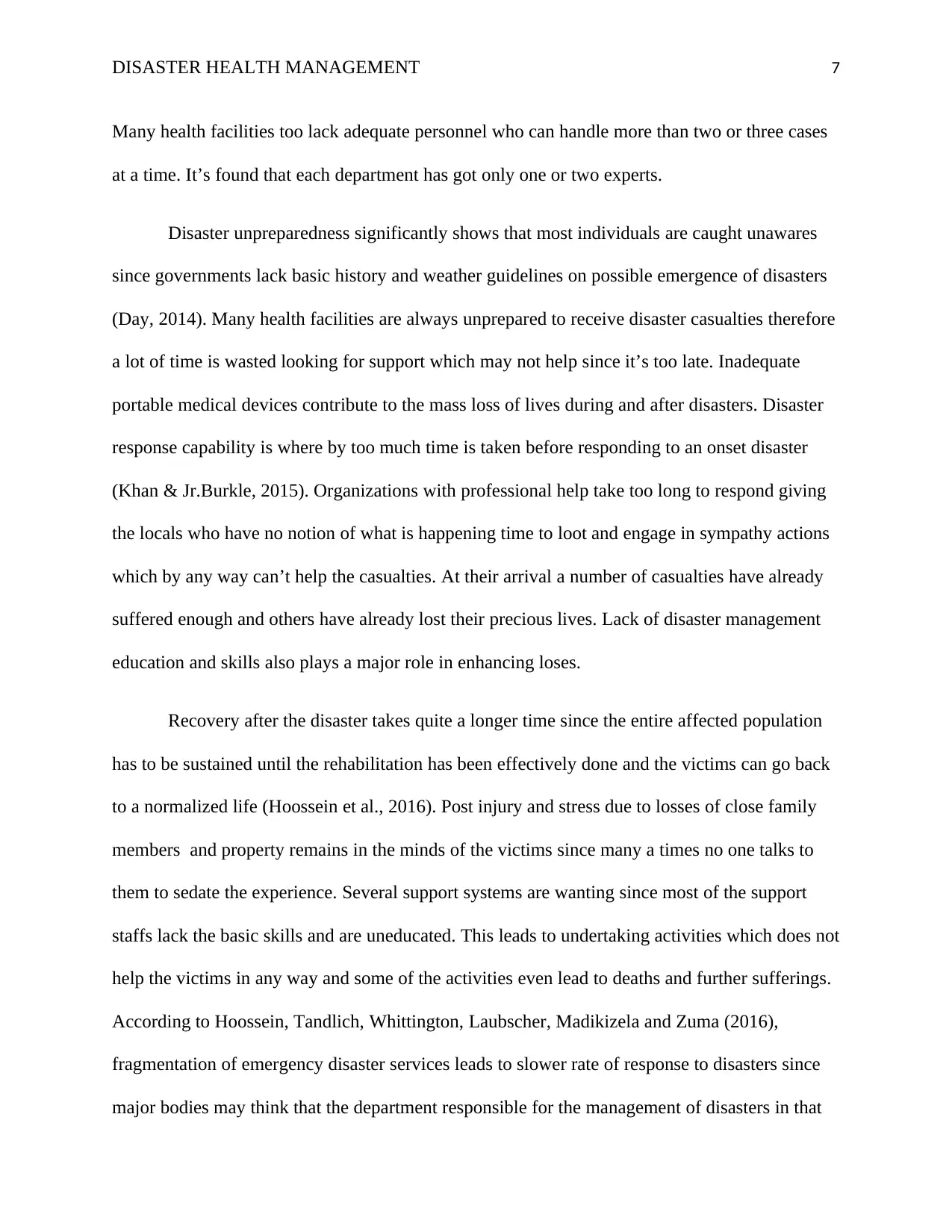
DISASTER HEALTH MANAGEMENT 7
Many health facilities too lack adequate personnel who can handle more than two or three cases
at a time. It’s found that each department has got only one or two experts.
Disaster unpreparedness significantly shows that most individuals are caught unawares
since governments lack basic history and weather guidelines on possible emergence of disasters
(Day, 2014). Many health facilities are always unprepared to receive disaster casualties therefore
a lot of time is wasted looking for support which may not help since it’s too late. Inadequate
portable medical devices contribute to the mass loss of lives during and after disasters. Disaster
response capability is where by too much time is taken before responding to an onset disaster
(Khan & Jr.Burkle, 2015). Organizations with professional help take too long to respond giving
the locals who have no notion of what is happening time to loot and engage in sympathy actions
which by any way can’t help the casualties. At their arrival a number of casualties have already
suffered enough and others have already lost their precious lives. Lack of disaster management
education and skills also plays a major role in enhancing loses.
Recovery after the disaster takes quite a longer time since the entire affected population
has to be sustained until the rehabilitation has been effectively done and the victims can go back
to a normalized life (Hoossein et al., 2016). Post injury and stress due to losses of close family
members and property remains in the minds of the victims since many a times no one talks to
them to sedate the experience. Several support systems are wanting since most of the support
staffs lack the basic skills and are uneducated. This leads to undertaking activities which does not
help the victims in any way and some of the activities even lead to deaths and further sufferings.
According to Hoossein, Tandlich, Whittington, Laubscher, Madikizela and Zuma (2016),
fragmentation of emergency disaster services leads to slower rate of response to disasters since
major bodies may think that the department responsible for the management of disasters in that
Many health facilities too lack adequate personnel who can handle more than two or three cases
at a time. It’s found that each department has got only one or two experts.
Disaster unpreparedness significantly shows that most individuals are caught unawares
since governments lack basic history and weather guidelines on possible emergence of disasters
(Day, 2014). Many health facilities are always unprepared to receive disaster casualties therefore
a lot of time is wasted looking for support which may not help since it’s too late. Inadequate
portable medical devices contribute to the mass loss of lives during and after disasters. Disaster
response capability is where by too much time is taken before responding to an onset disaster
(Khan & Jr.Burkle, 2015). Organizations with professional help take too long to respond giving
the locals who have no notion of what is happening time to loot and engage in sympathy actions
which by any way can’t help the casualties. At their arrival a number of casualties have already
suffered enough and others have already lost their precious lives. Lack of disaster management
education and skills also plays a major role in enhancing loses.
Recovery after the disaster takes quite a longer time since the entire affected population
has to be sustained until the rehabilitation has been effectively done and the victims can go back
to a normalized life (Hoossein et al., 2016). Post injury and stress due to losses of close family
members and property remains in the minds of the victims since many a times no one talks to
them to sedate the experience. Several support systems are wanting since most of the support
staffs lack the basic skills and are uneducated. This leads to undertaking activities which does not
help the victims in any way and some of the activities even lead to deaths and further sufferings.
According to Hoossein, Tandlich, Whittington, Laubscher, Madikizela and Zuma (2016),
fragmentation of emergency disaster services leads to slower rate of response to disasters since
major bodies may think that the department responsible for the management of disasters in that
Paraphrase This Document
Need a fresh take? Get an instant paraphrase of this document with our AI Paraphraser
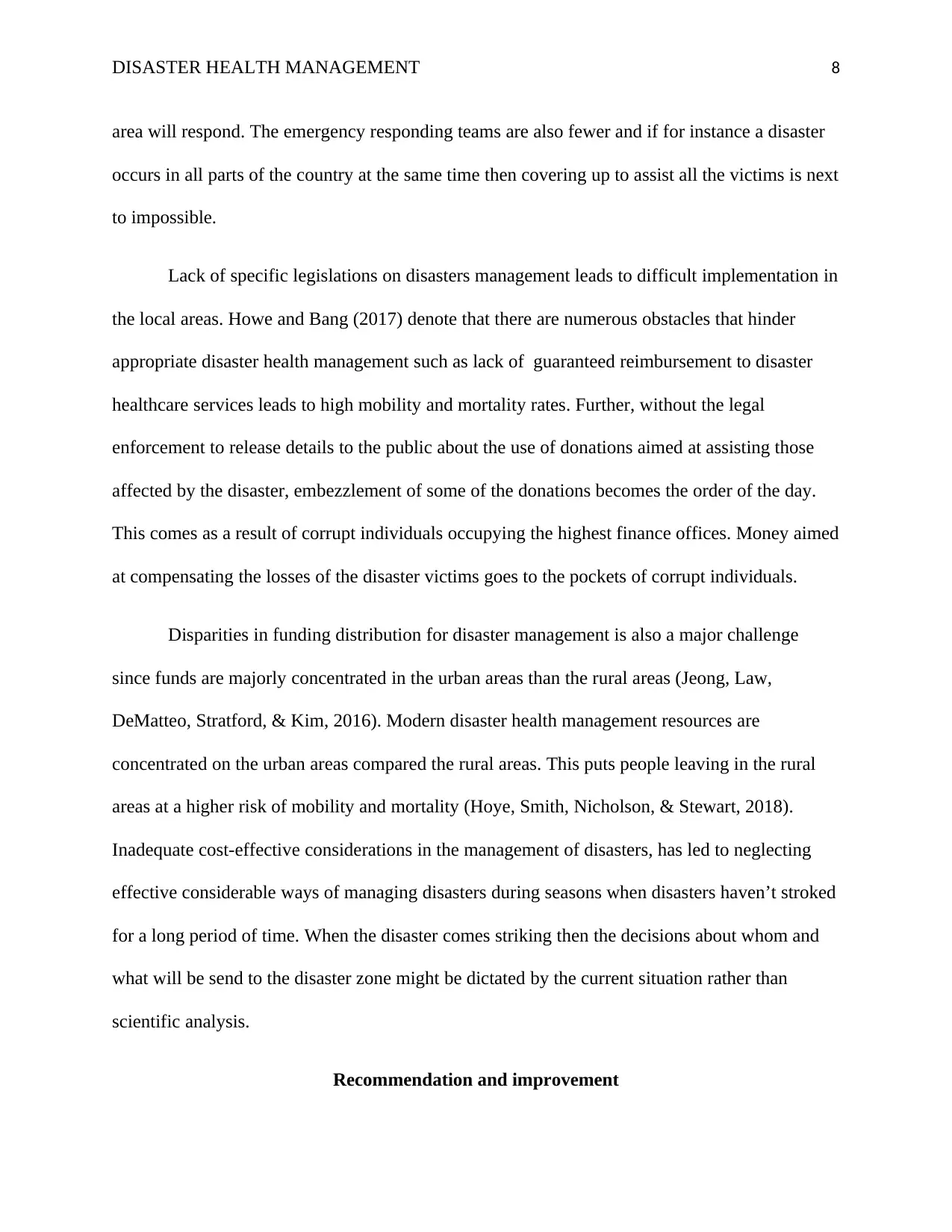
DISASTER HEALTH MANAGEMENT 8
area will respond. The emergency responding teams are also fewer and if for instance a disaster
occurs in all parts of the country at the same time then covering up to assist all the victims is next
to impossible.
Lack of specific legislations on disasters management leads to difficult implementation in
the local areas. Howe and Bang (2017) denote that there are numerous obstacles that hinder
appropriate disaster health management such as lack of guaranteed reimbursement to disaster
healthcare services leads to high mobility and mortality rates. Further, without the legal
enforcement to release details to the public about the use of donations aimed at assisting those
affected by the disaster, embezzlement of some of the donations becomes the order of the day.
This comes as a result of corrupt individuals occupying the highest finance offices. Money aimed
at compensating the losses of the disaster victims goes to the pockets of corrupt individuals.
Disparities in funding distribution for disaster management is also a major challenge
since funds are majorly concentrated in the urban areas than the rural areas (Jeong, Law,
DeMatteo, Stratford, & Kim, 2016). Modern disaster health management resources are
concentrated on the urban areas compared the rural areas. This puts people leaving in the rural
areas at a higher risk of mobility and mortality (Hoye, Smith, Nicholson, & Stewart, 2018).
Inadequate cost-effective considerations in the management of disasters, has led to neglecting
effective considerable ways of managing disasters during seasons when disasters haven’t stroked
for a long period of time. When the disaster comes striking then the decisions about whom and
what will be send to the disaster zone might be dictated by the current situation rather than
scientific analysis.
Recommendation and improvement
area will respond. The emergency responding teams are also fewer and if for instance a disaster
occurs in all parts of the country at the same time then covering up to assist all the victims is next
to impossible.
Lack of specific legislations on disasters management leads to difficult implementation in
the local areas. Howe and Bang (2017) denote that there are numerous obstacles that hinder
appropriate disaster health management such as lack of guaranteed reimbursement to disaster
healthcare services leads to high mobility and mortality rates. Further, without the legal
enforcement to release details to the public about the use of donations aimed at assisting those
affected by the disaster, embezzlement of some of the donations becomes the order of the day.
This comes as a result of corrupt individuals occupying the highest finance offices. Money aimed
at compensating the losses of the disaster victims goes to the pockets of corrupt individuals.
Disparities in funding distribution for disaster management is also a major challenge
since funds are majorly concentrated in the urban areas than the rural areas (Jeong, Law,
DeMatteo, Stratford, & Kim, 2016). Modern disaster health management resources are
concentrated on the urban areas compared the rural areas. This puts people leaving in the rural
areas at a higher risk of mobility and mortality (Hoye, Smith, Nicholson, & Stewart, 2018).
Inadequate cost-effective considerations in the management of disasters, has led to neglecting
effective considerable ways of managing disasters during seasons when disasters haven’t stroked
for a long period of time. When the disaster comes striking then the decisions about whom and
what will be send to the disaster zone might be dictated by the current situation rather than
scientific analysis.
Recommendation and improvement
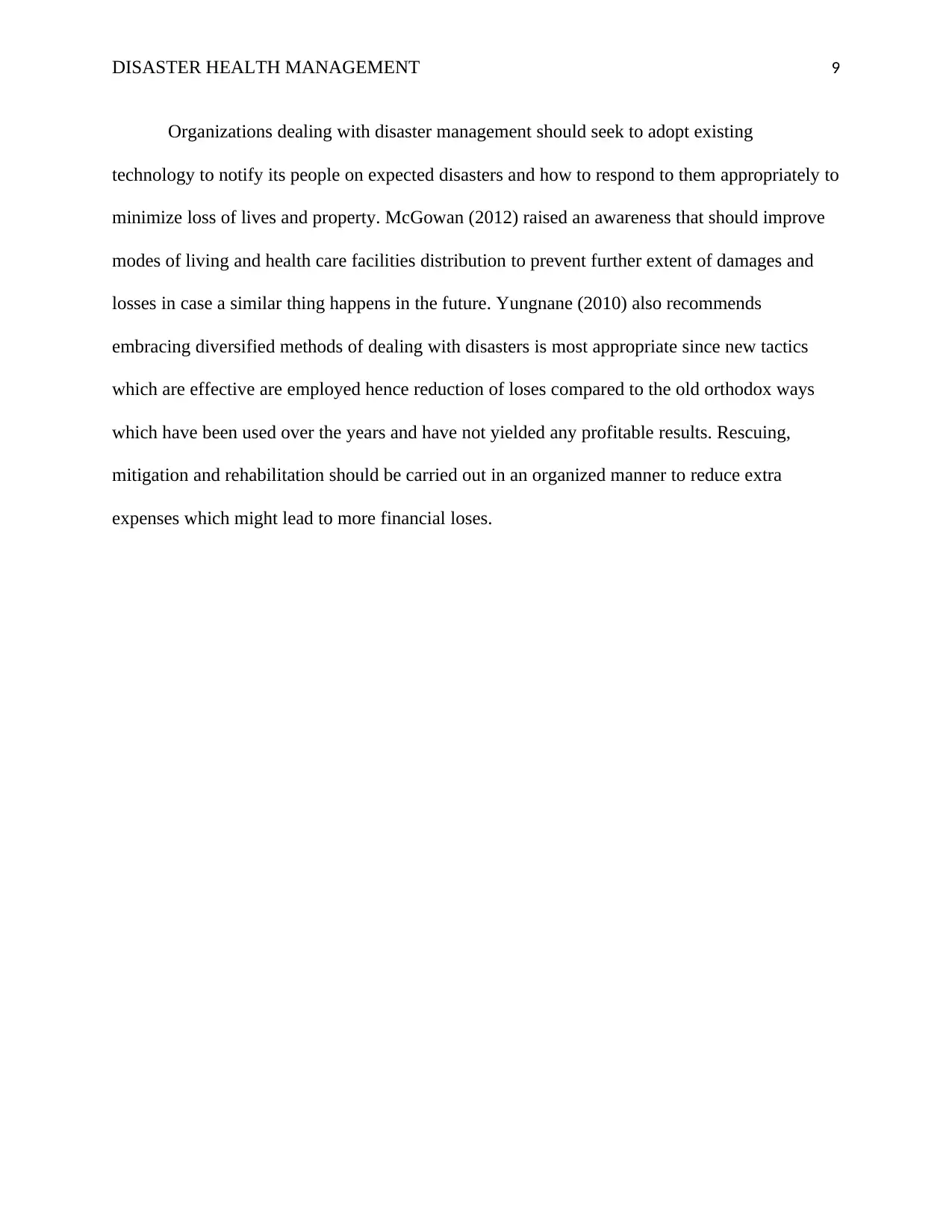
DISASTER HEALTH MANAGEMENT 9
Organizations dealing with disaster management should seek to adopt existing
technology to notify its people on expected disasters and how to respond to them appropriately to
minimize loss of lives and property. McGowan (2012) raised an awareness that should improve
modes of living and health care facilities distribution to prevent further extent of damages and
losses in case a similar thing happens in the future. Yungnane (2010) also recommends
embracing diversified methods of dealing with disasters is most appropriate since new tactics
which are effective are employed hence reduction of loses compared to the old orthodox ways
which have been used over the years and have not yielded any profitable results. Rescuing,
mitigation and rehabilitation should be carried out in an organized manner to reduce extra
expenses which might lead to more financial loses.
Organizations dealing with disaster management should seek to adopt existing
technology to notify its people on expected disasters and how to respond to them appropriately to
minimize loss of lives and property. McGowan (2012) raised an awareness that should improve
modes of living and health care facilities distribution to prevent further extent of damages and
losses in case a similar thing happens in the future. Yungnane (2010) also recommends
embracing diversified methods of dealing with disasters is most appropriate since new tactics
which are effective are employed hence reduction of loses compared to the old orthodox ways
which have been used over the years and have not yielded any profitable results. Rescuing,
mitigation and rehabilitation should be carried out in an organized manner to reduce extra
expenses which might lead to more financial loses.
⊘ This is a preview!⊘
Do you want full access?
Subscribe today to unlock all pages.

Trusted by 1+ million students worldwide
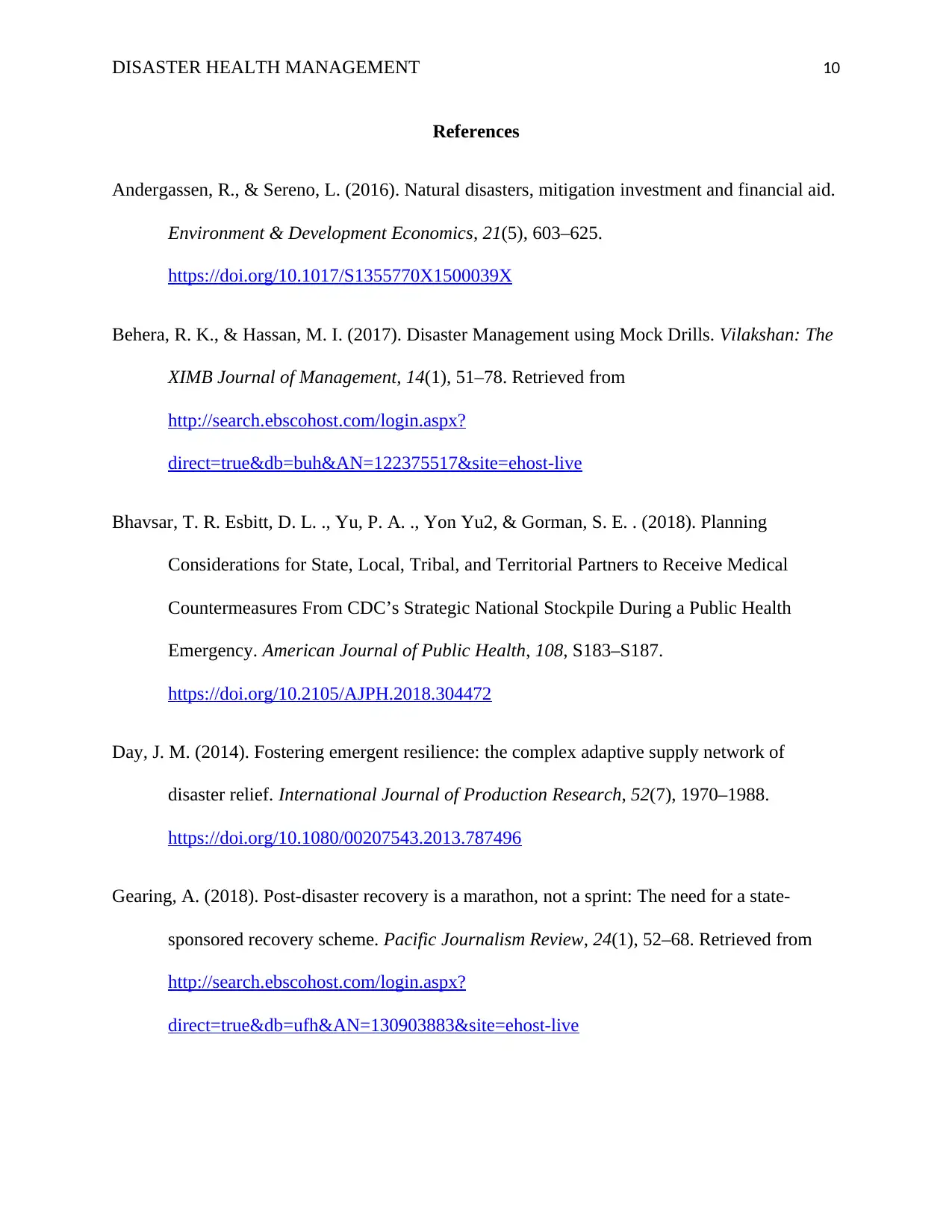
DISASTER HEALTH MANAGEMENT 10
References
Andergassen, R., & Sereno, L. (2016). Natural disasters, mitigation investment and financial aid.
Environment & Development Economics, 21(5), 603–625.
https://doi.org/10.1017/S1355770X1500039X
Behera, R. K., & Hassan, M. I. (2017). Disaster Management using Mock Drills. Vilakshan: The
XIMB Journal of Management, 14(1), 51–78. Retrieved from
http://search.ebscohost.com/login.aspx?
direct=true&db=buh&AN=122375517&site=ehost-live
Bhavsar, T. R. Esbitt, D. L. ., Yu, P. A. ., Yon Yu2, & Gorman, S. E. . (2018). Planning
Considerations for State, Local, Tribal, and Territorial Partners to Receive Medical
Countermeasures From CDC’s Strategic National Stockpile During a Public Health
Emergency. American Journal of Public Health, 108, S183–S187.
https://doi.org/10.2105/AJPH.2018.304472
Day, J. M. (2014). Fostering emergent resilience: the complex adaptive supply network of
disaster relief. International Journal of Production Research, 52(7), 1970–1988.
https://doi.org/10.1080/00207543.2013.787496
Gearing, A. (2018). Post-disaster recovery is a marathon, not a sprint: The need for a state-
sponsored recovery scheme. Pacific Journalism Review, 24(1), 52–68. Retrieved from
http://search.ebscohost.com/login.aspx?
direct=true&db=ufh&AN=130903883&site=ehost-live
References
Andergassen, R., & Sereno, L. (2016). Natural disasters, mitigation investment and financial aid.
Environment & Development Economics, 21(5), 603–625.
https://doi.org/10.1017/S1355770X1500039X
Behera, R. K., & Hassan, M. I. (2017). Disaster Management using Mock Drills. Vilakshan: The
XIMB Journal of Management, 14(1), 51–78. Retrieved from
http://search.ebscohost.com/login.aspx?
direct=true&db=buh&AN=122375517&site=ehost-live
Bhavsar, T. R. Esbitt, D. L. ., Yu, P. A. ., Yon Yu2, & Gorman, S. E. . (2018). Planning
Considerations for State, Local, Tribal, and Territorial Partners to Receive Medical
Countermeasures From CDC’s Strategic National Stockpile During a Public Health
Emergency. American Journal of Public Health, 108, S183–S187.
https://doi.org/10.2105/AJPH.2018.304472
Day, J. M. (2014). Fostering emergent resilience: the complex adaptive supply network of
disaster relief. International Journal of Production Research, 52(7), 1970–1988.
https://doi.org/10.1080/00207543.2013.787496
Gearing, A. (2018). Post-disaster recovery is a marathon, not a sprint: The need for a state-
sponsored recovery scheme. Pacific Journalism Review, 24(1), 52–68. Retrieved from
http://search.ebscohost.com/login.aspx?
direct=true&db=ufh&AN=130903883&site=ehost-live
Paraphrase This Document
Need a fresh take? Get an instant paraphrase of this document with our AI Paraphraser
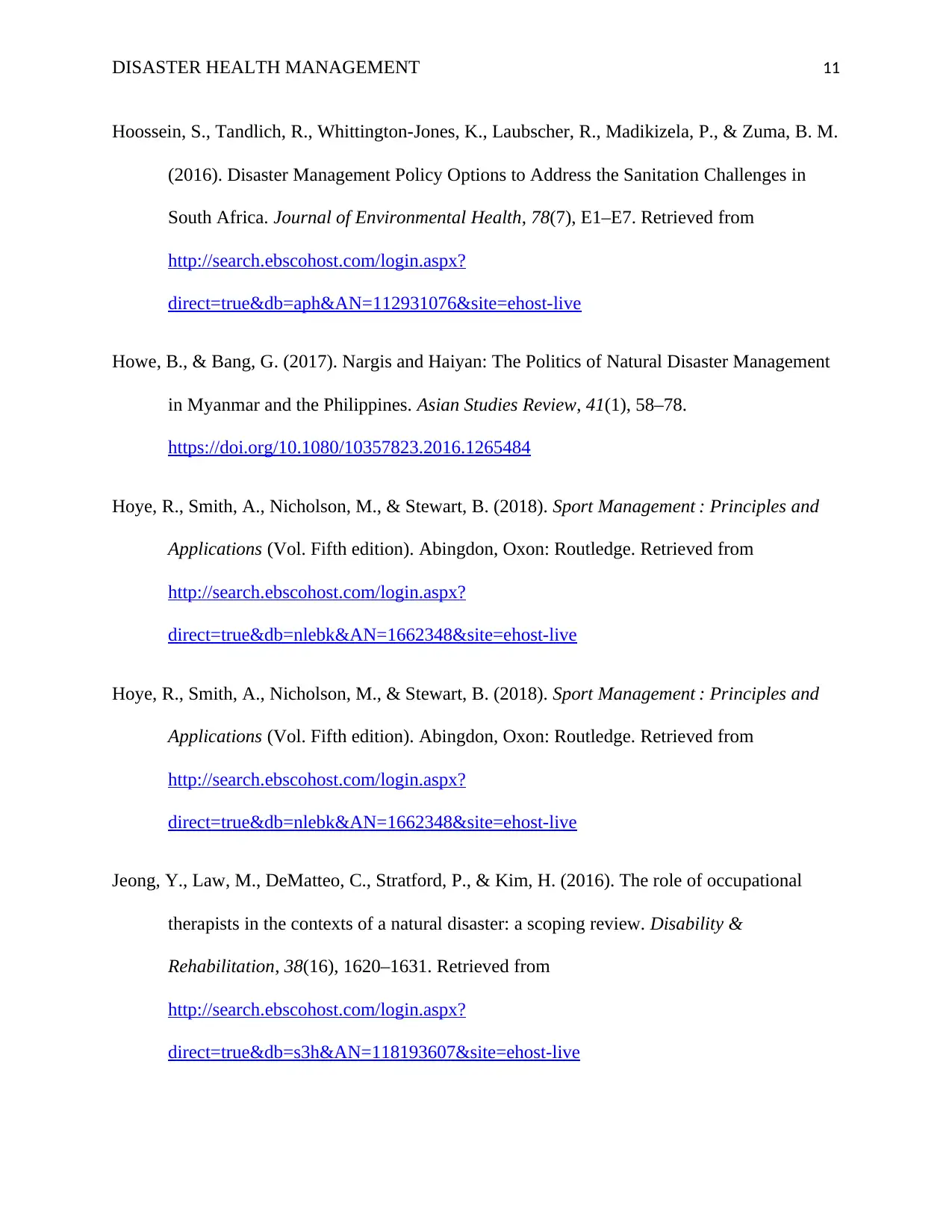
DISASTER HEALTH MANAGEMENT 11
Hoossein, S., Tandlich, R., Whittington-Jones, K., Laubscher, R., Madikizela, P., & Zuma, B. M.
(2016). Disaster Management Policy Options to Address the Sanitation Challenges in
South Africa. Journal of Environmental Health, 78(7), E1–E7. Retrieved from
http://search.ebscohost.com/login.aspx?
direct=true&db=aph&AN=112931076&site=ehost-live
Howe, B., & Bang, G. (2017). Nargis and Haiyan: The Politics of Natural Disaster Management
in Myanmar and the Philippines. Asian Studies Review, 41(1), 58–78.
https://doi.org/10.1080/10357823.2016.1265484
Hoye, R., Smith, A., Nicholson, M., & Stewart, B. (2018). Sport Management : Principles and
Applications (Vol. Fifth edition). Abingdon, Oxon: Routledge. Retrieved from
http://search.ebscohost.com/login.aspx?
direct=true&db=nlebk&AN=1662348&site=ehost-live
Hoye, R., Smith, A., Nicholson, M., & Stewart, B. (2018). Sport Management : Principles and
Applications (Vol. Fifth edition). Abingdon, Oxon: Routledge. Retrieved from
http://search.ebscohost.com/login.aspx?
direct=true&db=nlebk&AN=1662348&site=ehost-live
Jeong, Y., Law, M., DeMatteo, C., Stratford, P., & Kim, H. (2016). The role of occupational
therapists in the contexts of a natural disaster: a scoping review. Disability &
Rehabilitation, 38(16), 1620–1631. Retrieved from
http://search.ebscohost.com/login.aspx?
direct=true&db=s3h&AN=118193607&site=ehost-live
Hoossein, S., Tandlich, R., Whittington-Jones, K., Laubscher, R., Madikizela, P., & Zuma, B. M.
(2016). Disaster Management Policy Options to Address the Sanitation Challenges in
South Africa. Journal of Environmental Health, 78(7), E1–E7. Retrieved from
http://search.ebscohost.com/login.aspx?
direct=true&db=aph&AN=112931076&site=ehost-live
Howe, B., & Bang, G. (2017). Nargis and Haiyan: The Politics of Natural Disaster Management
in Myanmar and the Philippines. Asian Studies Review, 41(1), 58–78.
https://doi.org/10.1080/10357823.2016.1265484
Hoye, R., Smith, A., Nicholson, M., & Stewart, B. (2018). Sport Management : Principles and
Applications (Vol. Fifth edition). Abingdon, Oxon: Routledge. Retrieved from
http://search.ebscohost.com/login.aspx?
direct=true&db=nlebk&AN=1662348&site=ehost-live
Hoye, R., Smith, A., Nicholson, M., & Stewart, B. (2018). Sport Management : Principles and
Applications (Vol. Fifth edition). Abingdon, Oxon: Routledge. Retrieved from
http://search.ebscohost.com/login.aspx?
direct=true&db=nlebk&AN=1662348&site=ehost-live
Jeong, Y., Law, M., DeMatteo, C., Stratford, P., & Kim, H. (2016). The role of occupational
therapists in the contexts of a natural disaster: a scoping review. Disability &
Rehabilitation, 38(16), 1620–1631. Retrieved from
http://search.ebscohost.com/login.aspx?
direct=true&db=s3h&AN=118193607&site=ehost-live
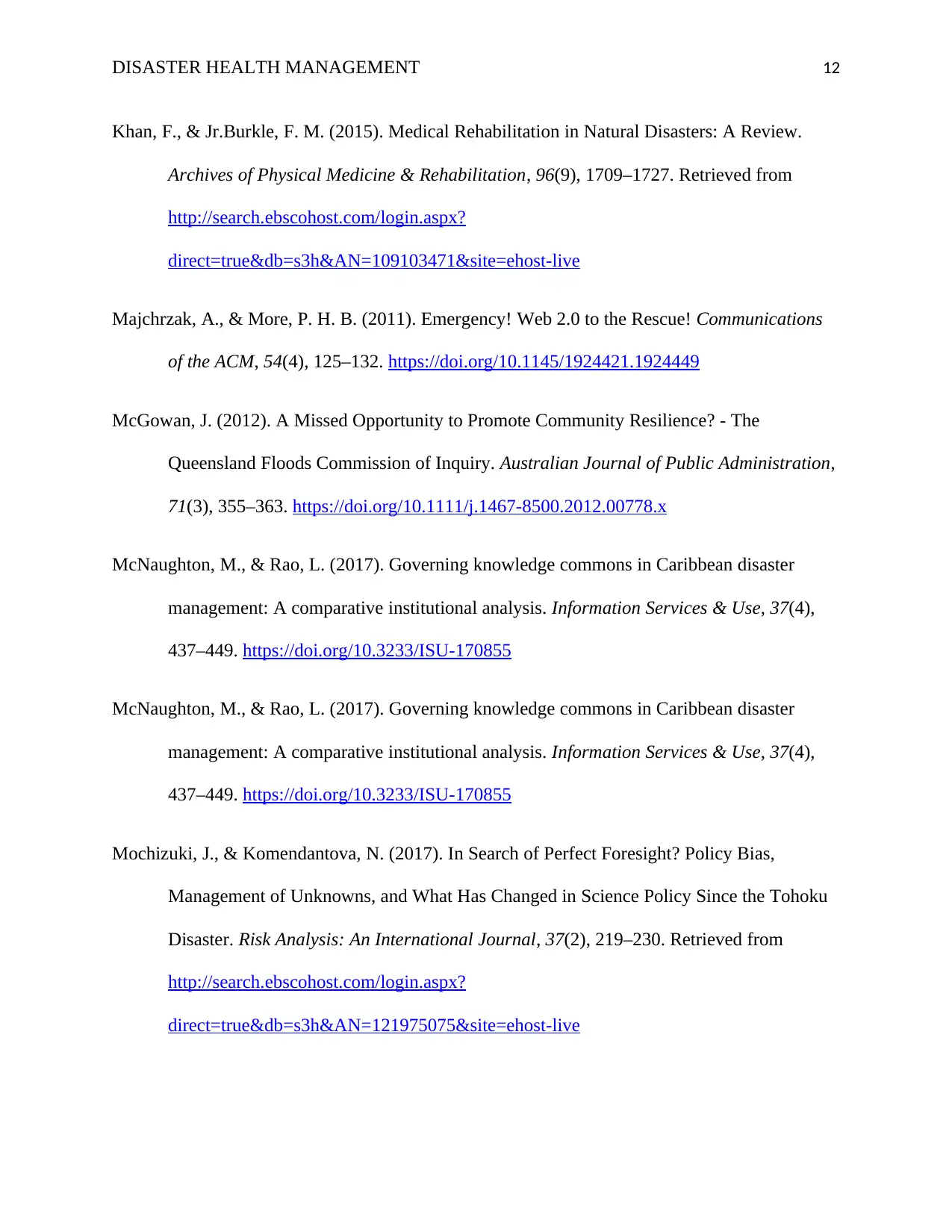
DISASTER HEALTH MANAGEMENT 12
Khan, F., & Jr.Burkle, F. M. (2015). Medical Rehabilitation in Natural Disasters: A Review.
Archives of Physical Medicine & Rehabilitation, 96(9), 1709–1727. Retrieved from
http://search.ebscohost.com/login.aspx?
direct=true&db=s3h&AN=109103471&site=ehost-live
Majchrzak, A., & More, P. H. B. (2011). Emergency! Web 2.0 to the Rescue! Communications
of the ACM, 54(4), 125–132. https://doi.org/10.1145/1924421.1924449
McGowan, J. (2012). A Missed Opportunity to Promote Community Resilience? - The
Queensland Floods Commission of Inquiry. Australian Journal of Public Administration,
71(3), 355–363. https://doi.org/10.1111/j.1467-8500.2012.00778.x
McNaughton, M., & Rao, L. (2017). Governing knowledge commons in Caribbean disaster
management: A comparative institutional analysis. Information Services & Use, 37(4),
437–449. https://doi.org/10.3233/ISU-170855
McNaughton, M., & Rao, L. (2017). Governing knowledge commons in Caribbean disaster
management: A comparative institutional analysis. Information Services & Use, 37(4),
437–449. https://doi.org/10.3233/ISU-170855
Mochizuki, J., & Komendantova, N. (2017). In Search of Perfect Foresight? Policy Bias,
Management of Unknowns, and What Has Changed in Science Policy Since the Tohoku
Disaster. Risk Analysis: An International Journal, 37(2), 219–230. Retrieved from
http://search.ebscohost.com/login.aspx?
direct=true&db=s3h&AN=121975075&site=ehost-live
Khan, F., & Jr.Burkle, F. M. (2015). Medical Rehabilitation in Natural Disasters: A Review.
Archives of Physical Medicine & Rehabilitation, 96(9), 1709–1727. Retrieved from
http://search.ebscohost.com/login.aspx?
direct=true&db=s3h&AN=109103471&site=ehost-live
Majchrzak, A., & More, P. H. B. (2011). Emergency! Web 2.0 to the Rescue! Communications
of the ACM, 54(4), 125–132. https://doi.org/10.1145/1924421.1924449
McGowan, J. (2012). A Missed Opportunity to Promote Community Resilience? - The
Queensland Floods Commission of Inquiry. Australian Journal of Public Administration,
71(3), 355–363. https://doi.org/10.1111/j.1467-8500.2012.00778.x
McNaughton, M., & Rao, L. (2017). Governing knowledge commons in Caribbean disaster
management: A comparative institutional analysis. Information Services & Use, 37(4),
437–449. https://doi.org/10.3233/ISU-170855
McNaughton, M., & Rao, L. (2017). Governing knowledge commons in Caribbean disaster
management: A comparative institutional analysis. Information Services & Use, 37(4),
437–449. https://doi.org/10.3233/ISU-170855
Mochizuki, J., & Komendantova, N. (2017). In Search of Perfect Foresight? Policy Bias,
Management of Unknowns, and What Has Changed in Science Policy Since the Tohoku
Disaster. Risk Analysis: An International Journal, 37(2), 219–230. Retrieved from
http://search.ebscohost.com/login.aspx?
direct=true&db=s3h&AN=121975075&site=ehost-live
⊘ This is a preview!⊘
Do you want full access?
Subscribe today to unlock all pages.

Trusted by 1+ million students worldwide
1 out of 14
Related Documents
Your All-in-One AI-Powered Toolkit for Academic Success.
+13062052269
info@desklib.com
Available 24*7 on WhatsApp / Email
![[object Object]](/_next/static/media/star-bottom.7253800d.svg)
Unlock your academic potential
Copyright © 2020–2025 A2Z Services. All Rights Reserved. Developed and managed by ZUCOL.





